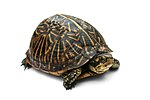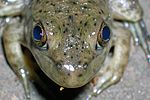Thermoregulation is the ability of an organism to keep its body temperature within certain boundaries, even when the surrounding temperature is very different...
55 KB (6,370 words) - 00:50, 14 August 2024
As in other mammals, human thermoregulation is an important aspect of homeostasis. In thermoregulation, body heat is generated mostly in the deep organs...
14 KB (1,840 words) - 21:55, 2 August 2024
Pinniped (redirect from Thermoregulation in pinnipeds)
Pinnipeds (pronounced /ˈpɪnɪˌpɛdz/), commonly known as seals, are a widely distributed and diverse clade of carnivorous, fin-footed, semiaquatic, mostly...
107 KB (12,646 words) - 05:22, 27 August 2024
Rabbit (redirect from Thermoregulation in rabbits)
hares.[page needed] Rabbits' ears are an important structure to aid thermoregulation as well as in detecting predators due to the way the outer, middle...
81 KB (8,723 words) - 22:03, 26 August 2024
Bat (redirect from Thermoregulation in bats)
water loss. Water helps maintain their ionic balance in their blood, thermoregulation system, and removal of wastes and toxins from the body via urine. They...
169 KB (18,238 words) - 04:04, 29 August 2024
Insect thermoregulation is the process whereby insects maintain body temperatures within certain boundaries. Insects have traditionally been considered...
16 KB (2,122 words) - 04:00, 19 June 2024
Homeothermy (category Thermoregulation)
Homeothermy, homothermy or homoiothermy is thermoregulation that maintains a stable internal body temperature regardless of external influence. This internal...
9 KB (1,040 words) - 04:12, 26 June 2024
Turtle (section Thermoregulation)
Turtles are reptiles of the order Testudines, characterized by a special shell developed mainly from their ribs. Modern turtles are divided into two major...
126 KB (13,111 words) - 12:38, 22 August 2024
keep the head clean when feeding, and also plays an important role in thermoregulation. Vultures have been observed to hunch their bodies and tuck in their...
25 KB (2,769 words) - 04:45, 9 August 2024
Mammal (section Thermoregulation)
in the spinal cord. The primary function of the fur of mammals is thermoregulation. Others include protection, sensory purposes, waterproofing, and camouflage...
221 KB (23,066 words) - 13:21, 29 August 2024
Cathemerality (section Thermoregulation)
fraction of illuminated moon in relation to sunset and sunrise times. Thermoregulation has been said to be an adaptive response that enables cathemeral animals...
14 KB (1,598 words) - 22:26, 1 August 2024
Newt (section Thermoregulation)
cutaneous water permeability, but promotes increased cutaneous blood flow. Thermoregulation, in combination with seasonal acclimation, describes the major mechanisms...
36 KB (3,836 words) - 01:38, 28 June 2024
Mesotherm (category Thermoregulation)
coined to advocate for an intermediate status of non-avian dinosaur thermoregulation, between endotherms and ectotherms. A more technical definition was...
7 KB (756 words) - 02:31, 22 September 2023
Skin temperature (section Thermoregulation)
Skin acts as both a medium and means for delivering mechanisms of thermoregulation, including insulation, sweating and control of blood flow. Skin tissue...
28 KB (3,243 words) - 05:27, 27 August 2023
Common ostrich (section Thermoregulation)
adaptations for thermoregulation, such as altering their feathers. Common ostriches display a feather fluffing behavior that aids them in thermoregulation by regulating...
122 KB (13,334 words) - 13:19, 26 August 2024
Pacific bluefin tuna (section Thermoregulation)
The Pacific bluefin tuna (Thunnus orientalis) is a predatory species of tuna found widely in the northern Pacific Ocean, but it is migratory and also recorded...
18 KB (1,925 words) - 16:07, 29 July 2024
chimpanzee, and other great apes. Loss of body hair in Homo links to the thermoregulation through perspiration heat dissipation required for activity in hot...
127 KB (14,244 words) - 23:22, 15 August 2024
Spring peeper (section Thermoregulation)
The spring peeper (Pseudacris crucifer) is a small chorus frog widespread throughout the eastern United States and Canada. It prefers permanent ponds due...
38 KB (4,475 words) - 03:13, 1 August 2024
Roadrunner (section Thermoregulation)
The roadrunners (genus Geococcyx), also known as chaparral birds or chaparral cocks, are two species of fast-running ground cuckoos with long tails and...
18 KB (1,711 words) - 14:21, 24 August 2024
Viviparous lizard (section Thermoregulation)
Zootoca vivipara lives in very cold climates, yet participates in normal thermoregulation instead of thermoconformity. They have the largest range of all terrestrial...
30 KB (3,373 words) - 11:22, 18 July 2024
which regulates circadian rhythmicity and hormone production for thermoregulation. The hole that contains the eye is known as the pineal foramen or parietal...
14 KB (1,592 words) - 19:28, 18 August 2024
Nelumbo (section Thermoregulation)
that can increase plant biomass or fruit mass. Other plants utilize thermoregulation in their life cycles. Among these is the eastern skunk cabbage, which...
23 KB (2,495 words) - 15:28, 27 July 2024
Black squirrel (section Thermoregulation)
that its frequency is the result of crypsis, and/or the result of thermoregulation. It has been theorized that non-melanistic gray squirrels have a concealment...
40 KB (4,495 words) - 02:23, 15 August 2024
Lazarus M, Saper CB (September 2009). "Parallel preoptic pathways for thermoregulation". The Journal of Neuroscience. 29 (38): 11954–64. doi:10.1523/JNEUROSCI...
50 KB (4,977 words) - 19:22, 27 August 2024
Shark (section Thermoregulation)
Sharks are a group of elasmobranch fish characterized by a cartilaginous skeleton, five to seven gill slits on the sides of the head, and pectoral fins...
143 KB (14,295 words) - 20:24, 27 August 2024
Nephila (section Thermoregulation)
Nephila is a genus of araneomorph spiders noted for the impressive webs they weave. Nephila consists of numerous species found in warmer regions around...
32 KB (3,989 words) - 14:30, 5 June 2024
Dimetrodon (section Thermoregulation)
used to stabilize its spine or to heat and cool its body as a form of thermoregulation. Some recent studies argue that the sail would have been ineffective...
83 KB (9,190 words) - 04:21, 25 August 2024
suspend central homeostasis, allowing large fluctuations in respiration, thermoregulation and circulation which do not occur in any other modes of sleeping or...
70 KB (8,445 words) - 19:37, 28 August 2024
Endotherm (category Thermoregulation)
mechanisms. In mammals, two separate homeostatic mechanisms are involved in thermoregulation—one mechanism increases body temperature, while the other decreases...
21 KB (2,493 words) - 00:54, 29 April 2024
killed off much of the area's seagrass (and which would have also made thermoregulation difficult for the sloths, with their slow metabolism). Ground sloths...
50 KB (5,420 words) - 09:47, 15 August 2024

























